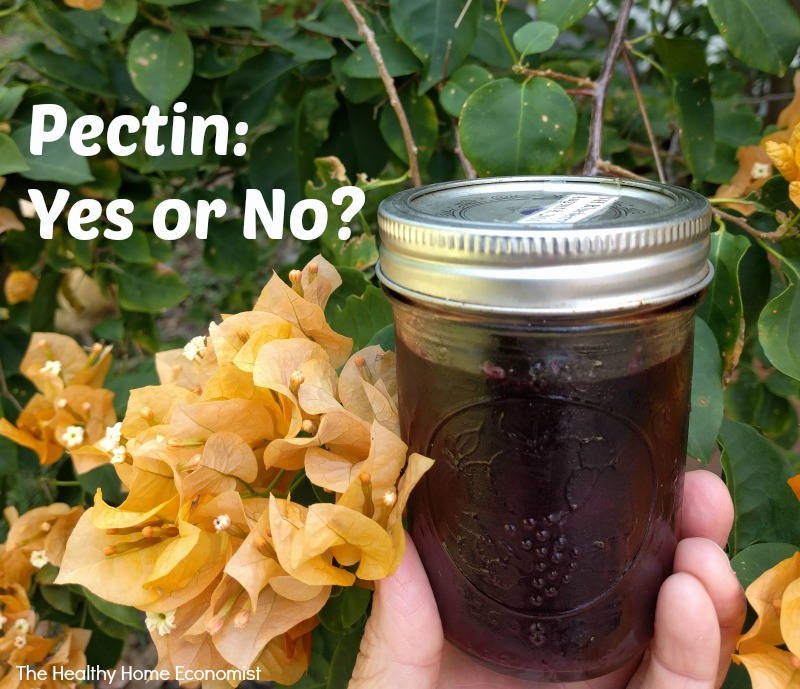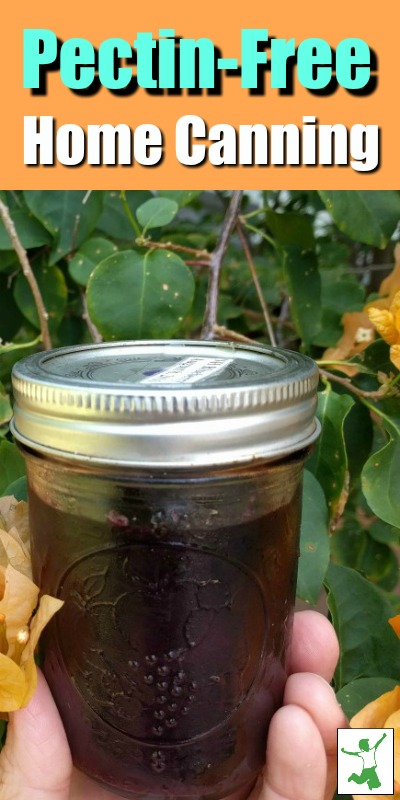Table of Contents[Hide][Show]

Pectin is an almost universal additive to commercially made jams and jellies. Even when homemade, this ingredient is commonly used to ensure a consistently gelled end result.
What many homemade jam and jelly enthusiasts don’t realize, however, is that pectin is not a desirable ingredient and should be avoided when an optimally healthy condiment is the goal.
The reasons are threefold.
Commercial Pectin
First, pectin can be made from corn and that usually means genetically modified corn unless the product is certified organic.
Even “all-natural” fruit versions are typically GMO based as they contain dextrose and citric acid, both corn-derived products. For example, take a look at the ingredients of Sure-Jell, a popular brand used by home canners:
Sure-Jell Ingredients: Dextrose, citric acid, fruit pectin.
While the fruit pectin itself isn’t a problem, the GMO dextrose and citric acid most definitely are.
Fruit Pectin Means High Sugar
Another reason to avoid commercial pectin is the amount of sugar that is required for it to work properly.
In order for commercial pectin to set, 55-85% of the jam or jelly must be sugar. This means that your homemade creation would contain more sugar than fruit!
Not exactly the type of spread you want your children using for breakfast toast before school for optimal learning and concentration.
Avoid Even Low Sugar Brands
What about low sugar versions, you may ask? This type of pectin binds with calcium instead of sugar to set properly and would allow the home canner to use much less sugar, no sugar, or a bit of stevia instead.
Low sugar pectins have the same problem as regular pectin in that they typically contain GMO ingredients. Here are the ingredients of low sugar Sure-Jell: (GMO corn) dextrose, fruit pectin, fumaric acid, sodium citrate.
While a low sugar brand like Pomona’s Universal Pectin uses only 100% citrus-derived ingredients, it, unfortunately, isn’t an organic product. Citrus trees are a highly sprayed crop with all manner of pesticides including a class of pesticides called cholinesterase inhibitors, known to be highly toxic to the nervous system. When citrus fruits arrive at the factory, the entire fruit is placed into the machines doing the processing – pesticides and all!
In addition, acid sprays are used to ensure that every drop of juice is extracted including the oil from the skin. These toxic residues (not listed on the ingredient label) are served up not just with commercial citrus juices, but additional products made with them such as citrus pectin.
Another lesser problem is that if you have hard water with high calcium content this may cause the jam to get overly firm, even rubbery.
Added Pectin?
Home canners, don’t despair! You don’t really need added pectin when making your favorite jam and jelly recipes.
The trick is to use fruit that is naturally high in pectin such as:
- Most apples
- Grapes
- Most berries
- Crabapples
- Currants
- Lemons
- Plums
- Raspberries
When making jam without added pectin, be sure to use fully ripe fruit only. Wash the fruit before cooking but do not soak. Remove stems, skins, and pits before cutting into pieces.
For jelly made without added pectin, select a mix of 3/4 ripe and 1/4 under-ripe fruit. Do not use commercially canned or frozen fruit juice as the pectin is too low. Crush soft, fully ripe fruits or berries and cut the firmer, under-ripe fruit into small pieces. Use the fruit peels and cores during cooking as this will add additional pectin.

Make Your Own!
If you feel that you really need to use pectin in your home canning efforts to ensure consistent results for the time spent, it is best to make your own to ensure a quality, GMO-free, pesticide-free product.
Here’s are the steps in a nutshell:
- Wash, but don’t peel about seven large tart ORGANIC apples. Granny Smith or crabapples work well.
- Cut the apples into pieces and add four cups of water and two tablespoons of organic lemon juice (fresh squeezed is ideal as it is higher in pectin than store-bought).
- Boil the mixture for 40 minutes, then strain it through an unbleached cheesecloth.
- Boil the juice for another 20 minutes, pour it into sterilized jars and seal.
- To test the pectin content of the concentrated juice, stir one tablespoon of grain or wood alcohol into one teaspoon of fruit juice. DO NOT TASTE! Juices that are high in natural pectin will form a lot of chunky gel. Those with an average pectin content will form a few pieces of the jelly-like substance. Low pectin juice that is low in pectin content will form only small, flaky pieces of sediment.
Knowing the pectin content of the final product will help you judge how much pectin to add to your homemade jam and jelly recipes which will vary with each batch of homemade pectin you produce.
Happy canning!
References
(1) Canning, Pickling and Freezing with Irma Harding
(2) Your Own Pectin Recipe
(3) Comparison of Low Sugar vs Traditional Pectin Recipe
More Information
How to Make Orangina







Great information! I’ve been making very small batches of strawberry preserves with berries from a local farmer. If I ever venture into making large batches of strawberry jam to can, I’m going to use these suggestions.
this is so worth the time…it works! and is how ladies used to do it. We have not gotten smarter, we have gotten lazy! and our health has become the victim~
yes for most people that is so true…
the best would be… smarter and not lazy.
….from a old Italiam mamma
I have used chia seeds and coconut sugar to make strawberry jam!! Super easy and so delicious and nutritious!
Do you have a recipe for your jam with chia? Id love to make it, We use chia a lot.
Awesome! I’ll have to look up the best way to do that! I’m planning to make a batch of tomato preserves with organic tomatoes & want to keep it all as organic as possible…
That has not been proven safe to use chia seeds and coconut sugar to can jams. Just because it’s on someone’s blog doesn’t mean that it has been tested over and over again for safety to prevent botulism. Good luck with the shelf life of your preserves/jams.
Most bloggers that post recipes for chia jam clearly state that it has to be kept in the freezer or has a short fridge life. It’s not preserved and I’ve never seen chia jam recipes that claim to be shelf stable.
you can make delicious spreads or sauces by spreading crushed or sliced fruit in pan and baking slowly at low temp. Experiment with various fruits, temps, and pan sizes. So far I’ve made the most delicious apple sauce, apple butter, jams/preserves, and tomato preserves (add Italian spices for the best tomato product for soups, stews, pasta).
My current favorite homemade jam is made with only mashed raspberries (could probably work with other berries too), honey, chia seeds. No cooking – takes only minutes to make. Google Raspberry Chia Seed Jam – lots of food blogs have a version of it.
No one is telling you what to do this information is for thoe of us who don’t want GMO’s in their food.
I use Chia seed as a natural pectin in my jam and it works great.
My great aunt and my mum used to make jam all the time when I was a kid and I’m sure they never even had access to pectin then… I grew up in a town where ‘lemon butter’ was made at a certain time of the year – it was SO delicious and I am almost certain that it was just lemons, sugar, eggs and butter – This blog is making me want to make some!!!
I find you have to use more granny smith apples with certain fruits like strawberries. I also use agar in lieu of pectin since you only need a small amount to get it to gel.
I have also made my own homemade pectin but really like just using the apples with making the jam.
Sometimes I will make a topping with fruit, sweetener cooked down on the stove and afterwards just kept it in the refrigerator. Making enough for a couple of weeks.